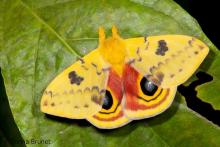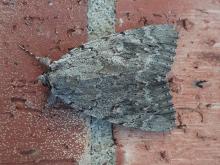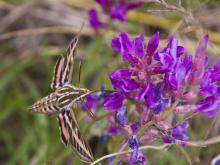Butterflies and Moths
Media

Species Types
Scientific Name
About 75 species in North America north of Mexico
Description
Missouri has 16 species of saturniid, or giant silkworm moths. Many of them are spectacular, including the cecropia, luna, buck, io, imperial, polyphemus, rosy maple, spiny oakworm, and royal moths.
Media

Species Types
Scientific Name
Hyalophora cecropia
Description
The cecropia moth looks a lot like butterfly ― but note its feathery antennae and stout, hairy body. This is the largest moth native to North America.
Media

Species Types
Scientific Name
Antheraea polyphemus
Description
The polyphemus is the second-largest Missouri moth. It was named after Homer's giant one-eyed monster in The Odyssey because of the big eyespot on each hindwing.
Media

Species Types
Scientific Name
Automeris io
Description
The wings of male Io moths are usually yellow; those of females are reddish brown. When prodded, this moth parts its forewings to reveal hindwings with huge eyespots.
Media

Species Types
Scientific Name
Catocala spp., more than 100 species in North America north of Mexico
Description
Dozens of species of underwing moths (genus Catocala) live in Missouri. They have drab tan forewings that usually conceal bright orange, red, yellow, or pink hindwings with contrasting bold dark patterns.
Media

Species Types
Scientific Name
More than 50 species in Missouri
Description
Sphinx moths are usually large and heavy bodied, with a long, pointed abdomen. Members of this family often hover near flowers, feeding on nectar and looking like hummingbirds or bumblebees.
Media

Species Types
Scientific Name
Hyles lineata
Description
The white-lined sphinx moth sometimes confuses people because it flies, hovers, and eats from flowers like a hummingbird. The adults often fly during daylight hours as well as in the night and are often found at lights.
Media

Species Types
Scientific Name
Ceratomia hageni
Description
Hagen's sphinx is also called Osage orange sphinx for its larval food plant. Fresh adults will have a beautiful olive-green cast, while older individuals will look more tan.
Media

Species Types
Scientific Name
Eacles imperialis
Description
The beautiful imperial moth is impossible to confuse with any other species in Missouri: the wings are yellow with spots and speckles of pink, orange, or rusty pale purple. Wingspan can be 5½ inches.
Media

Species Types
Scientific Name
More than 12,000 species in North America north of Mexico
Description
Learn about moths as a group. What makes a moth a moth? How are moths different from butterflies? What are the major groups of moths?
See Also


Media

Species Types
Scientific Name
About 1,500 species in North America north of Mexico
Description
Adult caddisflies are mothlike. Their larvae are aquatic and build portable, protective cases out of local materials, including grains of sand, bits of leaves and twigs, and other debris.
Media

Species Types
Scientific Name
Corydalus cornutus
Description
Adult eastern dobsonflies are huge and mothlike, with large wings and a weak, fluttery flight. The fiercely predaceous aquatic larvae, called hellgrammites, are well-known to anglers, who often use them as bait.
About Butterflies and Moths in Missouri
Butterflies, skippers, and moths belong to an insect order called the Lepidoptera — the "scale-winged" insects. These living jewels have tiny, overlapping scales that cover their wings like shingles. The scales, whether muted or colorful, seem dusty if they rub off on your fingers. Many butterflies and moths are associated with particular types of food plants, which their caterpillars must eat in order to survive.





















